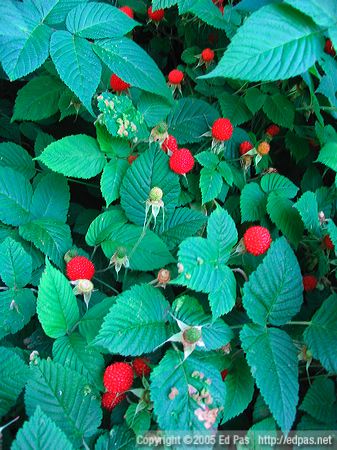I’ve been initiated into the grand Japanese tradition of gathering wild seasonal foodstuffs. Or rather, I’ve initiated myself into the tradition. At least every couple of days for the last few weeks I’ve seen one or more people picking plants, fruit, or flowers on public land. There have been broad-leafed greens in shaded woods. Japanese fiddleheads. Edible wild grasses. And so on.
Last week on Monday I noticed some berries growing on a bush in one of the hedges of the school’s front garden. I’d previously seen kids foraging in the overgrown vacant lot near the school so I figured they—the berries, not the kids—were probably edible. So, propelled by the culinary adventure gene I inherited from the Asian side of the family, I picked four plump juicy samples that were within easy reach.
Here’s a photo of some of the bushes growing beside the student entrance to the school grounds. This isn’t where I picked my first samples, but it’s my best photo of the bushes.

Before I could pop the juicy red morsels into my mouth, my survival instincts—overriding the millennia of evolution that gifted me with a cast-iron stomach—took over and I returned to the staff room where I asked someone if the berries were safe to eat. As with most of my recent questions in the staff room—the ones about Shintoism come most readily to mind—much discussion ensued. The verdict was that they were, in fact edible, and that it’s a pity that teachers these days don’t have time to go pick berries anymore. And mutterings along the lines of “How times have changed. When we were kids we used do stuff like that all the time.” Followed by wistful sighing. No time even when they’re growing wild on school property? A sign of the times, I suppose. The conclusion of all this debate and reflection was that the berries are related to strawberries and are edible. I gave one to each of the three members of this overworked impromptu fructobotany discussion group, and ate one very sweet berry myself. Meanwhile, I wondered if the “strawberry” conclusion was a fact, or simply the fact that my translator probably hadn’t ever heard of raspberries before.
Regardless, on Tuesday I went foraging again, and filled an empty drink bottle with berries to take home and share with Lia and Jarrod. I stored them for the afternoon in the staff room fridge, disguised in the drink bottle, with an empty drink box slipped over top, and copious amounts of plastic bagging. And just in case that didn’t stop any would-be berry thieves, I wrote my name—in English—on the outside.
My strategy worked. Here’s a picture of the berries, just before Lia and I started to eat them. Jarrod wasn’t home yet so we saved him a bunch.

They seem less like strawberries and more like raspberries. Here’s a close-up.

The plants are very much like raspberry bushes, in that they have thorns and canelike stalks. And the fruit themselves look a lot like raspberries, but don’t have the sour tanginess of the ones in Canada. And the fruity bits, the ones with the seeds inside, are much smaller. Oddly enough—and this is something Lia pointed out—the less ripe orangey ones are sweeter than the darker fruit.
I’m not sure if these count as “wild,” but the bushes don’t appear to have been planted on the school ground intentionally. They may have crept in from the “wilds” that surround the school. And no, I’m not planning to try my luck at collecting the elusive, expensive, and exquisite pine mushroom known in these parts as matsutake. It would certainly be worth it, but I don’t know if they grow in this region and besides, they won’t be in season again until after I’ve left the country.
I recall eating these berries in the high Atlas Mountains of Morocco in 1975…kids would stand by the roadside offering for sale a mound of berries in a “basket” made of leaves and twigs… they pleasant taste although somewhat bland and mealy… Alas, I have no idea what they are called, in arabic, japanese or english…
Further research—googling for japanese raspberry—reveals that the Latin name is Rubus parvifolius. A google image search on the Latin name returns a lot of pictures that look very similar to my plant photo above.
they were introduced to this country as ornamentals and also promoted as they have a covering over the fruit protecting them from wildlife until ripe.
they are still sold and heartily encouraged in this country by some unscrupulous and/or ignorant nurseries; however they are an invasive weed here and choke out the yummy native blackberries and raspberries that we picked as children.
and the wildlife gobble them quickly once they do ripen. and spread more of them. rather ugly with their red furry canes and the grey-white coloring of the underside of the leaves. and they die down in the winter. don’t know why they were considered ornamentals. and being rather tasteless compared to the native berries, who cares if the unripen berries are protected by a husk.
we rent the house we are living in now, otherwise i would remove them and replace them with berries indiginous to our area. i miss the wild raspberries and blackberries that used to grow here when i was a child and the birds and other critters did not gobble them in one sitting. plenty for all.
birds and land beavers (aka ground hogs, whistle pigs, wood chucks…cute but nasty and destructive GARDEN PESTS with huge appitites) scarf them up in a day or two. probably with the help of the overgrown deer population.
oh well, the deer population did not used to be overgrown before the lovely woodlands and family farms were turned into MCmansion subdivisions and bucks county is no longer historic bucks county.
it is called a thimbleberry.